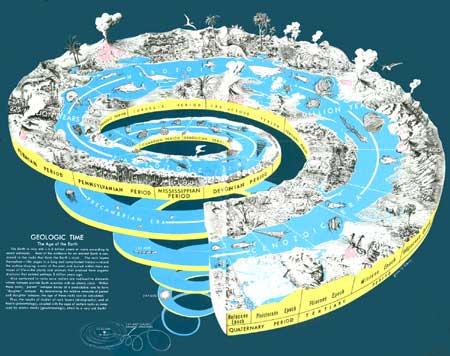
|
Geological Survey Bulletin 1393
The Geologic Story of Arches National Park |
SUMMARY OF GEOLOGIC HISTORY

HAVING FINISHED our geologic trip through Arches National Park, let us see how the arches and other features fit into the bigger scheme of things—the geologic age and events of the Earth as a whole, as depicted in figure 59. As shown in figure 4, the rock strata still preserved in the park range in age from Pennsylvanian to Cretaceous, or from about 300 million to 100 million years old—a span of about 200 million years. This seems an incredibly long time, until one notes that the earth is some 4.5 billion years old, and that our rock pile is but 1/23 or 4-1/2 percent of the age of the Earth as a whole. Thus, in figure 59, the rocks exposed in the park occupy only about the left half of the top whorl of the spiral.
But this is not the whole story. As indicated earlier, younger Mesozoic and Tertiary rocks more than 1 mile thick that once covered the area have been carried away by erosion, and if we include these the span is increased to about 250 million years, or nearly a full whorl of the spiral.
Deep tests for oil and gas tell us that much older rocks underlie the area, and we have seen that some of these played a part in shaping the park we see today. In addition to the Precambrian igneous and metamorphic rocks, there is about 2,000 feet of Paleozoic sedimentary rocks older than the Pennsylvanian Paradox Member of the Hermosa Formation, most of which was laid down in ancient seas. This includes strata of Cambrian, Ordovician, Devonian, Mississippian, and Pennsylvanian ages (fig. 59). There are some gaps in the rock record caused by temporary emergence of the land above sea level and erosion of the land surface before the land again subsided below sea level so that deposition could resume. Silurian rocks are absent, presumably because, here, the Silurian Period was dominated by erosion rather than deposition.
While Pennsylvanian and Permian rocks were being laid down in and southwest of the park, a large area to the northeast, called by geologists the Uncompahgre Highland (because it occupied the same general area as part of the present Uncompahgre Plateau), rose slowly above sea level. Whatever Paleozoic rocks were on this rising land plus part of the underlying Precambrian rocks were eroded and carried by streams into deep basins to the northeast and southwest. Thus, while some marine or near-shore deposits were being laid down in and south of the park, thousands of feet of red beds were being laid down by streams between the park and what is now the Uncompahgre Plateau. During part of Middle Pennsylvanian time, a large area, including the park, known as the Paradox basin, was alternately connected to or cut off from the sea, so that the water was evaporated during cutoff periods and replenished during periods when connection with the sea resumed. In these huge evaporation basins were deposited the salt and gypsum plus some potash salts and shale that now make up the Paradox Member of the Hermosa Formation.
Arches National Park contains four northwesterly trending major folds—the Salt Valley and Cache Valley salt anticlines, the Courthouse syncline, and the faulted Moab—Seven Mile anticline, which forms the southwestern border. How these folds were formed was explained on pages 27-32. The history of their growth, however, was a long one that began about 300 million years ago in the Pennsylvanian and ended about 50 million years ago in the early Tertiary. The growth of these folds occurred in two stages. The first stage, which involved the development of the salt cores of the anticlines, ended in the Jurassic with the beginning of Morrison time; the second stage, which involved additional folding that intensified the magnitude and shape of existing folds, occurred in the early Tertiary and was followed later by collapse of the salt anticlines. The formation and collapse of the Salt Valley and Cache Valley anticlines was accompanied by pronounced jointing (fig. 12), which allowed differential erosion to produce the tall fins in which the arches were formed.
The old Uncompahgre Highland continued to shed debris into the bordering basins until Triassic time, when it began to be covered by a veneer of red sandstone and siltstone of the Chinle Formation (Lohman, 1965). The area remained above sea level during the Triassic Period and most, if not all, of the Jurassic Period, although the Jurassic Carmel Formation was laid down in a sea that lay just to the west.
Late in the Cretaceous Period a large part of Central and Southeastern United States, including the eastern half of Utah, sank beneath the sea and received thousands of feet of mud, silt, and some sand that later compacted into the Mancos Shale. This formation, as well as all younger and some older strata, has long since been eroded from most of the park area, but a little of the Mancos is preserved in the Cache Valley graben (fig. 11), and the entire Mancos Shale and younger rocks are present in adjacent areas, such as the Book Cliffs north of Green River, Crescent Junction, and Cisco (figs. 7, 50, 56).
The land rose above the sea at about the close of the Cretaceous and has remained above ever since, although inland basins and lakes received sediment during parts of the Tertiary Period. Compressive forces in the Earth's crust produced some gentle folding of the strata at the close of the Cretaceous, but more pronounced folding and some faulting occurred during the Eocene Epoch, when most of the Rocky Mountains took form. During the Miocene Epoch igneous rock welled up into older rocks to form the cores of the nearby La Sal, Abajo, and Henry Mountains. Additional uplift and some folding occurred in the Pliocene and Pleistocene Epochs.
Much of the course of the Colorado River was established during the Miocene Epoch, with some additional adjustments in the late Pliocene and early Pleistocene Epochs (Hunt, C. B., 1969, p. 67). Erosion during much of the Tertiary Period and all of the Quaternary Period plus some sagging and breaking of the crest of the anticlines, brought on by solution and lateral squeezing of salt beds beneath the Moab—Seven Mile, Salt Valley, and Cache Valley anticlines, combined to produce the landscape as we now see it.
The Precambrian rocks beneath the area are about 1.5 billion years old; so an enormous span of time is represented by the rocks and events in and beneath Canyonlands National Park.
If we consider the geologic formations that make up the national parks (N.P.), national monuments (N.M.) (excluding small historical or archaeological ones), Monument Valley, San Rafael Swell, and Glen Canyon National Recreation Area, all in the Colorado Plateau, it becomes apparent that certain formations or groups of formations play starring roles in some parks or monuments, some play supporting roles, and in a few places the entire cast of rocks gets about equal billing. Let us compare them and see how and where they fit into the "Geologic Time Spiral" (fig. 59).
Dinosaur N.M., with exposed rocks ranging in age from Precambrian to Cretaceous, covers the greatest time span (nearly 2 billion years), but has one unit—the Jurassic Morrison Formation—in the starring role, for this unit contains the many dinosaur fossils that give the monument its name and fame, although there are several older units in supporting roles. Grand Canyon N.P. and N.M. are next, with rocks ranging in age from Precambrian through Permian (excluding the Quaternary lava flows in the N.M.), but here there is truly a team effort, for the entire cast gets about equal billing. Canyonlands N.P. stands third in this category, with rocks ranging from Pennsylvanian to Jurassic, but we would have to give top billing to the Permian Cedar Mesa Sandstone Member of the Cutler Formation, from which The Needles, The Grabens, and most of the arches were sculptured; the Triassic Wingate Sandstone and the Triassic (?) Kayenta Formation get second billing for their roles in forming and preserving Island in the Sky and other high mesas.
Now let us consider other areas with only one or few players in the cast, beginning at the bottom of the time spiral. Black Canyon of the Gunnison N.M., cut entirely in rocks of early Precambrian age with only a veneer of much younger rocks, obviously has but one star in its cast. Colorado N.M. contains rocks ranging from Precambrian to Cretaceous—equal to Dinosaur in this respect, but Colorado is unique in that all the rocks of the long Paleozoic Era and some others are missing from the cast; of those that remain, the Triassic Wingate and the Triassic (?) Kayenta are the stars, with strong support from the Jurassic Entrada Sandstone.
All the bridges in Natural Bridges N.M. were carved from the Permian Cedar Mesa Sandstone Member of the Cutler Formation, also one of the stars in Canyonlands N.P. In Canyon de Chelly (pronounced dee shay) N.M. and Monument Valley (neither a national park nor a national monument, as it is owned and administered by the Navajo Tribe), the De Chelly Sandstone Member of the Cutler Formation—a Permian member younger than the Cedar Mesa—plays the starring role.
Wupatki N.M. near Flagstaff, Ariz., stars the Triassic Moenkopi Formation. Petrified Forest N.P. (which now includes part of the Painted Desert) has but one star—the Triassic Chinle Formation, in which are found many petrified logs and stumps of ancient trees. The Triassic Jurassic Glen Canyon Group (fig. 19), which includes the Triassic Wingate Sandstone, the Triassic (?) Kayenta Formation, and the Triassic (?)-Jurassic Navajo Sandstone, receives top billing in recently enlarged Capitol Reef N.P., but the Triassic Moenkopi and Chinle Formations enjoy supporting roles.
The Triassic (?)-Jurassic Navajo Sandstone, which has a supporting role in Arches N.P., is the undisputed star of Zion N.P., Rainbow Bridge N.M., and Glen Canyon National Recreation Area, despite the fact that the latter is the type locality of the entire Glen Canyon Group. The Navajo also forms the impressive reef at the east edge of the beautiful San Rafael Swell, a dome, or closed anticline, now crossed by Highway I—70 between Green River and Fremont Junction, Utah.
As we journey upward in the time spiral (fig. 59), we come to the Jurassic Entrada Sandstone, which stars in Arches N.P., with help from the underlying Navajo Sandstone, and a supporting cast of both older and younger rocks. The Entrada also forms the grotesque erosion forms called "hoodoos and goblins" in Goblin Valley State Park, north of Hanksville, Utah.
Moving ever upward in the spiral, we come to the Cretaceous—the age of the starring Mesaverde Group, in which the caves of Mesaverde N.P. were formed, and which now house beautifully preserved ruins once occupied by the Anasazi, the same ancient people who once dwelt in Arches N.P. and nearby areas.
This brings us up to the Tertiary Period, during the early part of which the pink limestones and shales of the Paleocene and Eocene Wasatch Formation were laid down in inland basins. Beautifully sculptured cliffs, pinnacles, and caves of the Wasatch star in Bryce Canyon N.P. and in nearby Cedar Breaks N.M. This concludes our climb up the time spiral, except for Quaternary volcanoes and some older volcanic features at Sunset Crater N.M., near Flagstaff, Ariz.
Thus, one way or another, many rock units formed during the last couple of billion years have performed on the stage of the Colorado Plateau and, hamlike, still lurk in the wings eagerly awaiting your applause to recall them to the footlights. Don't let them down—visit and enjoy the national parks and monuments of the Plateau, for they probably are the greatest collection of scenic wonder-lands in the world.
| <<< Previous | <<< Contents >>> | Next >>> |
bul/1393/sec11.htm
Last Updated: 8-Jan-2007
